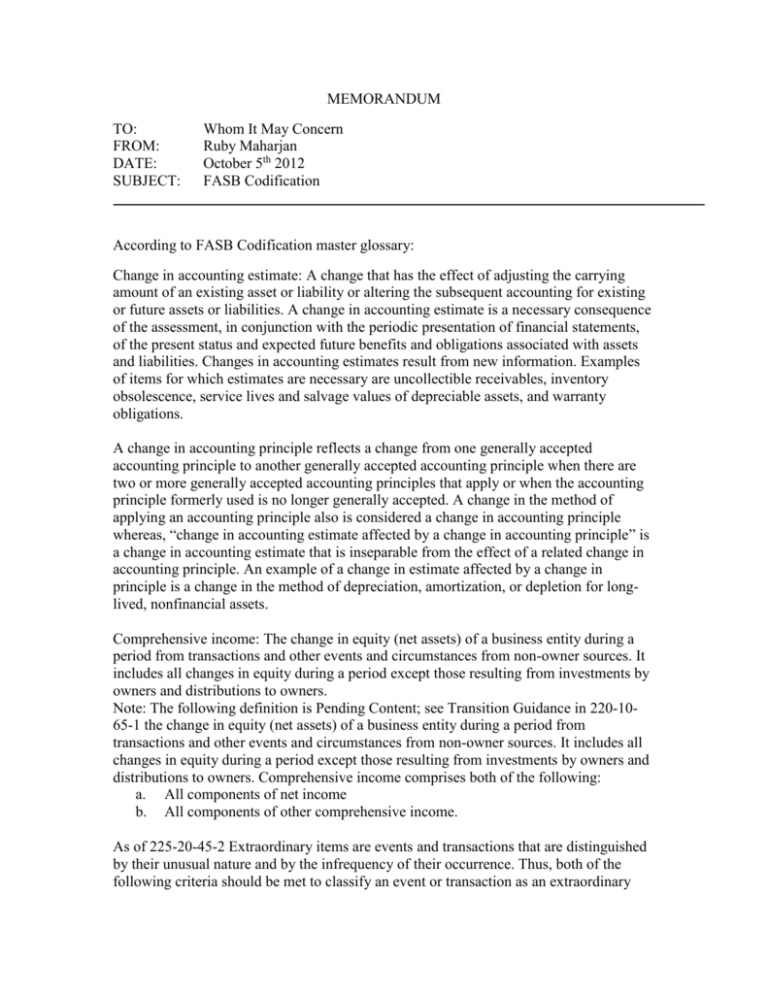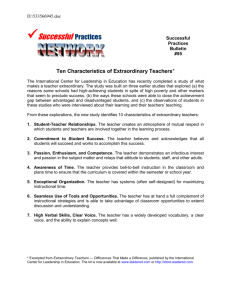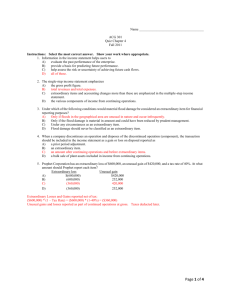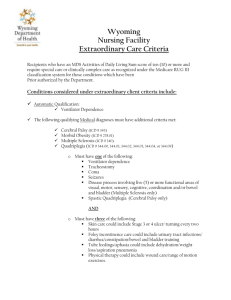MEMORANDUM TO: Whom It May Concern FROM: Ruby Maharjan
advertisement

MEMORANDUM TO: FROM: DATE: SUBJECT: Whom It May Concern Ruby Maharjan October 5th 2012 FASB Codification According to FASB Codification master glossary: Change in accounting estimate: A change that has the effect of adjusting the carrying amount of an existing asset or liability or altering the subsequent accounting for existing or future assets or liabilities. A change in accounting estimate is a necessary consequence of the assessment, in conjunction with the periodic presentation of financial statements, of the present status and expected future benefits and obligations associated with assets and liabilities. Changes in accounting estimates result from new information. Examples of items for which estimates are necessary are uncollectible receivables, inventory obsolescence, service lives and salvage values of depreciable assets, and warranty obligations. A change in accounting principle reflects a change from one generally accepted accounting principle to another generally accepted accounting principle when there are two or more generally accepted accounting principles that apply or when the accounting principle formerly used is no longer generally accepted. A change in the method of applying an accounting principle also is considered a change in accounting principle whereas, “change in accounting estimate affected by a change in accounting principle” is a change in accounting estimate that is inseparable from the effect of a related change in accounting principle. An example of a change in estimate affected by a change in principle is a change in the method of depreciation, amortization, or depletion for longlived, nonfinancial assets. Comprehensive income: The change in equity (net assets) of a business entity during a period from transactions and other events and circumstances from non-owner sources. It includes all changes in equity during a period except those resulting from investments by owners and distributions to owners. Note: The following definition is Pending Content; see Transition Guidance in 220-1065-1 the change in equity (net assets) of a business entity during a period from transactions and other events and circumstances from non-owner sources. It includes all changes in equity during a period except those resulting from investments by owners and distributions to owners. Comprehensive income comprises both of the following: a. All components of net income b. All components of other comprehensive income. As of 225-20-45-2 Extraordinary items are events and transactions that are distinguished by their unusual nature and by the infrequency of their occurrence. Thus, both of the following criteria should be met to classify an event or transaction as an extraordinary item: a. Unusual nature. The underlying event or transaction should possess a high degree of abnormality and be of a type clearly unrelated to, or only incidentally related to, the ordinary and typical activities of the entity, taking into account the environment in which the entity operates (see paragraph 225-20-60-3). b. Infrequency of occurrence. The underlying event or transaction should be of a type that would not reasonably be expected to recur in the foreseeable future, taking into account the environment in which the entity operates (see paragraph 225-20-60-3). Thus, “unusual nature” is o ne of the criterions that determine whether an item meets the definition of an extraordinary item. According to 270-10-50-5 Extraordinary Items, Unusual and Infrequent Items, and Disposals of Components Extraordinary items shall be disclosed separately and included in the determination of net income for the interim period in which they occur. In determining materiality, extraordinary items shall be related to the estimated income for the full fiscal year. In addition, matters such as unusual seasonal results, business combinations, and acquisitions by not-for-profit entities shall be disclosed to provide information needed for a proper understanding of interim financial reports. Therefore, loss in the second quarter of the year should be reported as extraordinary in the second quarter interim report. 260-10-S55-1 Effect of Preferred Stock Dividends and Accretion of Carrying Amount of Preferred Stock on Earnings Per Share See paragraph 225-10-S99-5, SAB Topic 6.B, for SEC Staff views on this topic. As of 225-10-S99-5 The following is the text of SAB Topic 6.B, Accounting Series Release 280-General Revision Of Regulation S-X: Income Or Loss Applicable To Common Stock. Facts: A registrant has various classes of preferred stock. Dividends on those preferred stocks and accretions of their carrying amounts cause income applicable to common stock to be less than reported net income. Question: In ASR 280, the Commission stated that although it had determined not to mandate presentation of income or loss applicable to common stock in all cases, it believes that disclosure of that amount is of value in certain situations. In what situations should the amount be reported, where should it be reported, and how should it be computed? Interpretive Response: Income or loss applicable to common stock should be reported on the face of the income statement FN1 when it is materially different in quantitative terms from reported net income or loss FN2 or when it is indicative of significant trends or other qualitative considerations. The amount to be reported should be computed for each period as net income or loss less: (a) dividends on preferred stock, including undeclared or unpaid dividends if cumulative; and (b) periodic increases in the carrying amounts of instruments reported as redeemable preferred stock (as discussed in Topic 3.C) or increasing rate preferred stock (as discussed in Topic 5.Q). FN1 If a registrant elects to follow the encouraged disclosure discussed in paragraph 23 of Statement 130 [paragraph 220-10-45-9], and displays the components of other comprehensive income and the total for comprehensive income using a one-statement approach, the registrant must continue to follow the guidance set forth in the SAB Topic. One approach may be to provide a separate reconciliation of net income to income available to common stock below comprehensive income reported on a statement of income and comprehensive income. FN2 The assessment of materiality is the responsibility of each registrant. However, absent concerns about trends or other qualitative considerations, the staff generally will not insist on the reporting of income or loss applicable to common stock if the amount differs from net income or loss by less than ten percent.






